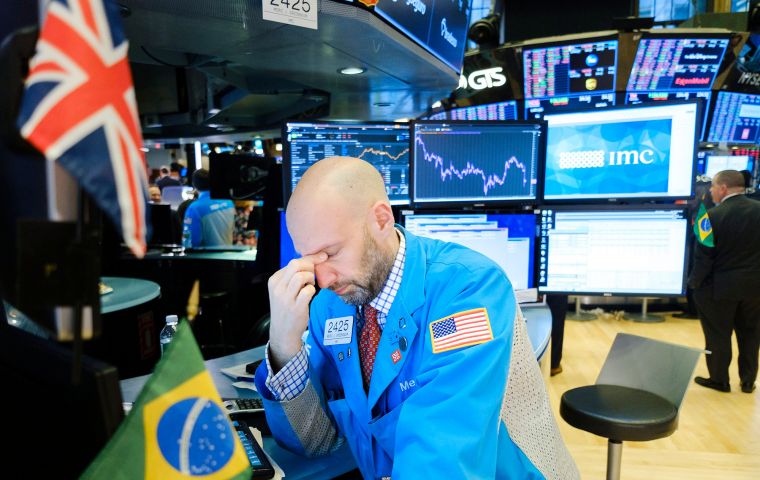MercoPress. South Atlantic News Agency
Coronavirus panic in markets wipes US$ 14 trillion in a month
 Even after its worst crash since Black Monday in 1987 overnight, Dow futures are down about 3% in Asia, as are S&P 500 futures.
Even after its worst crash since Black Monday in 1987 overnight, Dow futures are down about 3% in Asia, as are S&P 500 futures. Global stock markets crashed on Friday, ending a years-long bull run, with coronavirus panic selling hitting almost every asset class and leaving investors nowhere to hide. Half a trillion dollars in liquidity from the U.S. Federal Reserve and the promise of more were not enough to calm the fear that has wiped some US$14 trillion from world stocks in a month.
On Friday, Japanese stocks were in freefall and markets from Seoul to Jakarta punched through down limit circuit breakers. The Nikkei dropped as far as 10% and is heading for its worst week since the 2008 financial crisis. Not one stock on the index is in positive territory.
Losses were equally staggering outside Japan, driving MSCI’s broad Asia-Pacific index back to where it was in 2017. Gold and oil fell and once-safe sovereign bonds slumped as investors liquidated everything they could to cover losses.
Even after its worst crash since Black Monday in 1987 overnight, Dow futures are down about 3% in Asia, as are S&P 500 futures.
“There is a sense of fear and panic,” said James Tao, an analyst at stockbroker Commsec in Sydney, where phones at the high-value client desk rang non-stop.
“It’s one of those situations where there is so much uncertainty that no-one quite knows how to respond...if it’s fight or flight, many people are choosing flight at the moment.”
Australia's benchmark fell as far as 8% and is set for its worst week on record. In South Korea the won was shredded and the Kospi fell 7.7%.Hong Kong's Hang Seng index fell 5%. China's Shanghai composite fell 3%
In currency markets the dollar was king and Asian currencies hemorrhaged as fears of systemic risks drove demand for the world’s reserve currency. Majors stabilized after furious dollar buying overnight, with the euro finding footing around US$1.1200
The plunge, as the coronavirus pandemic spreads, gathered pace after U.S. President Donald Trump spooked investors with a move to restrict travel from Europe, and after the European Central Bank disappointed markets by holding back on rate cuts.
The VIX volatility index - Wall Street’s “fear gauge” - and an equivalent measure of volatility for the Euro Stoxx 50 hit their highest since the 2008 financial crisis.
Gold usually a safe harbor in times of panic, has fallen 4% to US$1,563.42 an ounce in two days. Bond yields, which rise when prices fall, lifted on long-dated U.S. Treasuries overnight and held there on Friday.
Sovereign 10-year yields for Australia, Japan, New Zealand, Thailand, Korea and Singapore rose.
To try and head off the sort of dislocation that saw markets seize up during the financial crisis more than a decade ago, the New York Federal Reserve surprised by pumping huge amounts of cash into the banking system.
After adding US$ 500 billion on Thursday, it will inject another US$ 1 trillion on Friday in an effort to stop borrowing costs from rising. Australia’s central bank injected an unusually large US$ 5.5 billion into the financial system.
In commodities, Brent crude is set for its biggest weekly drop since 1991 and was going backwards on Friday.Brent LCOc1 was down 50 cents, or 1.5%, at US$ 32.74 a barrel after falling more than 7% on Thursday. U.S. crude CLc1 was down 1.6% at US$ 30.99 per barrel.




Top Comments
Disclaimer & comment rulesCommenting for this story is now closed.
If you have a Facebook account, become a fan and comment on our Facebook Page!